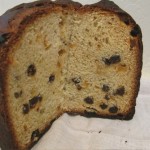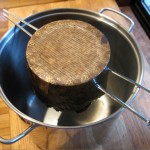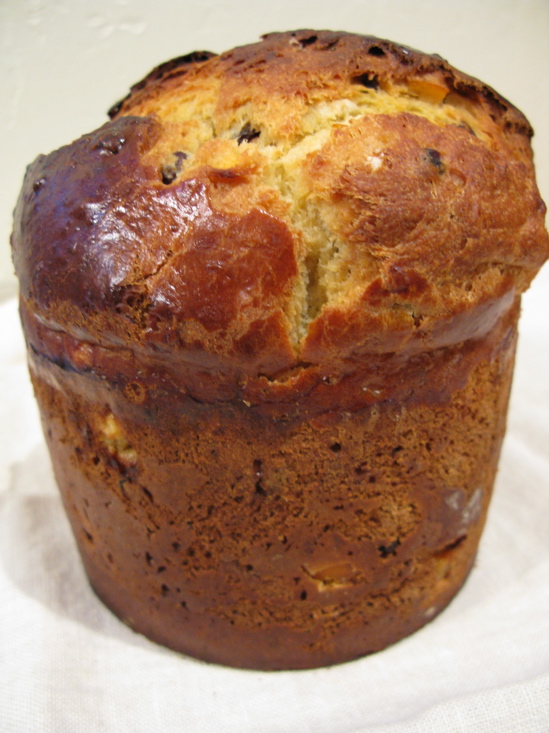Attention bakers: It’s not too late to make your own golden panettone for Christmas.
It doesn’t have to take days of fiddling with starters and multiple mixings of dough. And if the results aren’t quite as delicate as the festive bread from Milan’s best bakeries, they certainly beat the packaged panettone found at most stores. Just think of the bragging rights.
I love the light, airy texture and sweet, buttery flavor of this traditional Italian celebration bread at its best. I’m not so fond, however, of the bitter chunks of citron and rock-like raisins in most commercial panettone. So when I ran across Jim Lahey’s recipe in the December Gourmet, I couldn’t resist.
Lahey, owner of New York’s Sullivan Street Bakery, is a baking hero. He developed the terrific no-knead bread that Mark Bittman made famous in the New York Times two years ago. It uses a very wet dough and a long, slow rise to achieve a marvelous open crumb and crisp, golden crust. He employs the same techniques to create an exemplary panettone with very little yeast, highlighting the flavors of butter, eggs, vanilla and plump fruit.
 The recipe is relatively easy. You combine the ingredients in a mixer, let the dough rise for 12-15 hours in a cold oven, quickly shape the loaf and then let rise again 3-5 hours before baking. While the large loaf is still hot, you poke skewers through the sides about an inch from the bottom and hang it upside down in a large soup pot to keep it from collapsing while it cools.
The recipe is relatively easy. You combine the ingredients in a mixer, let the dough rise for 12-15 hours in a cold oven, quickly shape the loaf and then let rise again 3-5 hours before baking. While the large loaf is still hot, you poke skewers through the sides about an inch from the bottom and hang it upside down in a large soup pot to keep it from collapsing while it cools.
The only problem here is timing. If you have other things to do – last minute shopping, for instance – you have to calculate backward to figure out when to begin so you’ll be there for the final rise and baking. Since my house is always rather cool, my bread ended up needing the maximum time to rise sufficiently, which threw off the rest of my schedule.
The rise just wouldn’t be rushed, no matter where I put the dough in my search for a warmer spot. In the end, it was a choice between going to my regular yoga class or baking off the panettone. The bread won. The freshly baked bread was so good, however, that I didn’t begrudge it my lost class. The crumb was finely grained and vanilla bean infused the panettone with a haunting aroma and incomparable flavor.
Gourmet hasn’t put the recipe on its web site at this writing but you’ll find it on page 187 of the December issue.
Since I’ve never been known to leave well enough alone, I also went looking for a recipe that might work better with my schedule. I found it in “Artisan Bread in Five Minutes a Day,” by Jeff Hertzberg and Zoe Francois (Thomas Dunne Books, 2006).
I’m a fan of Hertzberg and Francois’ pragmatic approach to home bread baking. They also use a wet dough that requires no kneading, but timing is much more flexible because most of the rising is done in the refrigerator on no set schedule. You can mix up the egg- and butter-rich dough one day and bake it off anytime in the next five days with only a 1 hour and 40 minute rise on the counter once you’ve shaped the dough.
The additional yeast in this recipe shifts the flavor balance more to the side of bread than Lahey’s, which comes closer to cake. So I lifted a few ideas from the Gourmet panettone, adding sugar, macerating the currants in a little rum and hot water in advance, and a using a vanilla bean – pod and all – rather than vanilla extract. I even cooled one of the loaves upside down in a large pot as Lahey instructed. But it didn’t seem to make any difference, perhaps because these loaves were only half the size of Lahey’s. They’re a better size for gift giving.
adding sugar, macerating the currants in a little rum and hot water in advance, and a using a vanilla bean – pod and all – rather than vanilla extract. I even cooled one of the loaves upside down in a large pot as Lahey instructed. But it didn’t seem to make any difference, perhaps because these loaves were only half the size of Lahey’s. They’re a better size for gift giving.
This is the recipe I’m most likely to use again when I don’t have hours to spend waiting for bread to rise. It’s quite good and far better than any panettone I’ve ever purchased. Then again, I’ve never quite been able bring myself to spring more than $40 for a tin of premium imported bread at Williams-Sonoma.
You’ll need paper panettone molds or charlotte molds from a specialty cookware store, or clean 2 pound coffee cans with foil collars, to make this treat at home. Some people even use bundt cake pans although they don’t produce the traditional shape. All but the paper molds must be buttered in advance.
Most any kind of dried or candied fruit will work in panettone. Raisins are traditional. So is citron, but I prefer candied orange peel. If you can’t find the peel, Francois has instructions for making your own on her blog. Just remember to soak any really dry fruit for at least an hour in advance to prevent it from soaking up all the moisture in the dough.
To test whether the bread was done, I used a trick I picked up from the King Arthur baking blog this year. Insert an instant-read thermometer into the center of the bread. When it reads 190 degrees, the bread is ready. Otherwise, insert a wooden skewer into the center. It should come out only slightly moist.
So here it is, Panettone just in time for Christmas.
Makes three 1½ pound loaves
1 cup golden raisins, currants or dried cherries
2 tablespoons light rum
2 tablespoons hot water
1½ tablespoons active dry yeast (1½ packets)
1½ cups lukewarm water
1½ tablespoons salt
½ cup honey
½ cup sugar
8 eggs, lightly beaten
1 cup (2 sticks) unsalted butter, melted and cooled slightly
1 tablespoon grated lemon zest
1 vanilla bean, split lengthwise
7½ cups unbleached all-purpose flour
1½ cups mixed dried or candied fruit
Egg wash (1 egg beaten with 1 tablespoon water)
Soak raisins, currants or cherries with rum and hot water in a small bowl for at least an hour until fruit is plump and has soaked up most of the liquid. This can be done in advance with the fruit left overnight to soak.
In the large bowl of a heavy-duty stand mixer, blend the yeast, lukewarm water, salt, sugar, honey, eggs, melted butter, zest and vanilla seeds scraped from the bean. Reserve the pod. Mix in the flour, using the dough hook, and blend until all the flour is incorporated. (Alternatively, blend ingredients with a wooden spoon in a 5-quart bowl or lidded, but not airtight, food container. You may need to use wet hands to finish the job.)
Stir in drained raisins, currants or cherries and other dried or candied fruit. Transfer dough to a 5-quart bowl or lidded, but not airtight, food container. Tie a piece of string to the reserved vanilla bean pod and push the pod into the dough, hanging the string over the edge of the bowl or container so you can easily fish the pod out after the dough rises. Cover the dough lightly with plastic wrap or container lid and set aside at room temperature until dough rises, then flattens on top, approximately 2 hours.
Refrigerate dough and use anytime over the next five days. Dough should be well-chilled for easier handling.
On baking day, grease pan with a small amount of butter. Sprinkle flour over the surface of the refrigerated dough and cut off an approximately 1½ pound piece. (That’s a third of the dough, about the size of a cantaloupe.) The dough will still be very wet and sticky. Pull out the vanilla pod, dust the chunk of dough with just enough flour to make it easy to handle and quickly shape it into a ball, stretching the sides around to the bottom and pinching the edges together. Place the ball in the paper mold or buttered pan, seam side down.
Loosely cover the dough with plastic wrap and let rise at room temperature for 1 hour and 40 minutes. About 20 minutes before baking, preheat oven to 375 degrees.
Remove plastic wrap, brush top of the dough with egg wash and bake in the center of the preheated oven for about 50-55 minutes, depending on the amount of dough and size of the pan. The panettone will be a deep golden brown and sound hollow when tapped on the bottom. The internal temperature should be about 190 degrees. You may have to cover the top lightly with aluminum foil if it begins to get too dark.
Allow bread to cool completely before slicing and eating.
Note: Dough may be frozen in 1½ pound packets in an air-tight container for up to four weeks. Thaw in refrigerator for 24 hours before shaping, rising and baking as directed above.
Adapted from “Artisan Bread in Five Minutes a Day”


I’m so excited to see this post because I love, love, love panettone but would NEVER have thought to make it myself. And I had no idea there was a recipe for it in Artisan Bread Baking in 5 Minutes a Day, which I own. (I must admit, every time I think of making a new recipe from that book I always end up making the classic boule instead — it’s just so perfect every time.)
Isn’t that book brilliant? The classic boule is a winner, for sure, but the pizza dough is right up there. Such great results for so little effort.
I recently purchased my first bread maker – now researching to get the most out of it. Been doing a lot of bookmarking 🙂
I’ve never even considered making my own panettone (we always buy ours) but now that I’ve seen your gorgeous picture I think I’d be a fool not to try!